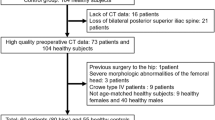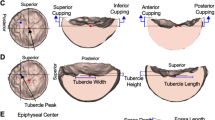Abstract
Developmental dysplasia of the hip (DDH) is a common abnormality that causes elevated contact stress and early onset osteoarthritis (OA). We hypothesized that adaptation of femoral head bone mineral density (BMD) patterns to focal loading during postnatal development could be used to identify hips at risk of degeneration. Evolving BMD patterns of the femoral head secondary center of ossification (SCO) were quantified and tested for differences with hip subluxation and degeneration. BMD was measured using quantitative computed tomography of hips in a canine model of DDH from 4 weeks to early skeletal maturity at 32 weeks. During body weight and SCO volumetric growth deceleration, SCO mean BMD increased rapidly and local regions of high BMD formed. Greater subluxation was associated with a lower mean BMD up to 14 weeks. At 32 weeks, greater subluxation was associated with a larger area of high BMD that was more laterally located and had a greater maximum BMD. BMD differences were associated with a higher probability of cartilage degeneration. Measurement and visualization of BMD pattern changes due to altered mechanical loading provide a basis for identifying hips at risk of early onset OA and a tool for surgical planning of contact stress reduction procedures.







Similar content being viewed by others
References
Burden of Musculoskeletal Disease Overview. In: United States Bone and Joint Decade: The Burden of Musculoskeletal Diseases in the United States. Rosemont, IL: American Academy of Orthopaedic Surgeons, 2008, pp. 1–19. ISBN 978-0-89203-533-5.
Agresti, A. Categorical Data Analysis. New York: Wiley-Interscience, p. 734, 2002.
Babis, G. C., V. I. Sakellariou, M. I. O’Connor, A. D. Hanssen, and F. H. Sim. Proximal femoral allograft-prosthesis composites in revision hip replacement: a 12-year follow-up study. J. Bone Joint Surg. Br. 92:349–355, 2010.
Berry, D. J., W. S. Harmsen, M. E. Cabanela, and B. F. Morrey. Twenty-five-year survivorship of two thousand consecutive primary Charnley total hip replacements: factors affecting survivorship of acetabular and femoral components. J. Bone Joint Surg. Am. 84A:171–177, 2002.
Buckwalter, J. A., C. Saltzman, and T. Brown. The impact of osteoarthritis: implications for research. Clin. Orthop. Relat. Res. 427(Suppl.):S6–S15, 2004.
Burton-Wurster, N., J. P. Farese, R. J. Todhunter, and G. Lust. Site-specific variation in femoral head cartilage composition in dogs at high and low risk for development of osteoarthritis: insights into cartilage degeneration. Osteoarthr. Cartil. 7:486–497, 1999.
Clohisy, J. C., P. E. Beaule, A. O’Malley, M. R. Safran, and P. Schoenecker. AOA symposium. Hip disease in the young adult: current concepts of etiology and surgical treatment. J. Bone Joint Surg. Am. 90:2267–2281, 2008.
Cunningham, T., R. Jessel, D. Zurakowski, M. B. Millis, and Y. J. Kim. Delayed gadolinium-enhanced magnetic resonance imaging of cartilage to predict early failure of Bernese periacetabular osteotomy for hip dysplasia. J. Bone Joint Surg. Am. 88:1540–1548, 2006.
Eckstein, F., C. R. Jacobs, and B. R. Merz. Mechanobiological adaptation of subchondral bone as a function of joint incongruity and loading. Med. Eng. Phys. 19:720–728, 1997.
Farndale, R. W., C. A. Sayers, and A. J. Barrett. A direct spectophotmetric microassay for sulfated glycosaminoglycans in cartilage cultures. Connect. Tissue Res. 9:247–248, 1982.
Gille, U., and F. V. Salomon. Bone growth in ducks through mathematical models with special reference to the Janoschek growth curve. Growth Dev. Aging 59:207–214, 1995.
Gonzalez, R. C., and R. E. Woods. Digital Image Processing. Upper Saddle River: Prentice Hall, 2002, 793 pp.
Gray, M. L., D. Burstein, and Y. Xia. Biochemical (and functional) imaging of articular cartilage. Semin. Musculoskelet. Radiol. 5:329–343, 2001.
Jacobsen, S., L. Romer, and K. Soballe. The other hip in unilateral hip dysplasia. Clin. Orthop. Relat. Res. 446:239–246, 2006.
Jacobsen, S., and S. Sonne-Holm. Hip dysplasia: a significant risk factor for the development of hip osteoarthritis A cross-sectional survey. Rheumatology 44:211–218, 2005.
Jee, W. S. Integrated bone tissue physiology: anatomy and physiology. In: Bone Mechanics Handbook, edited by S. C. Cowin. Boca Raton: CRC Press LLC, 2001, pp. 1.1–1.68.
Koo, M. W., K. H. Yang, P. Begeman, M. Hammami, and W. W. Koo. Prediction of bone strength in growing animals using noninvasive bone mass measurements. Calcif. Tissue Int. 68:230–234, 2001.
Kostis, W. J., A. P. Reeves, D. F. Yankelevitz, and C. I. Henschke. Three-dimensional segmentation and growth-rate estimation of small pulmonary nodules in helical CT images. IEEE Trans. Med. Imaging 22:1259–1274, 2003.
Littell, R. C. Analysis of unbalanced mixed model data: a case study comparison of ANOVA versis REML/GLS. J. Agric. Biol. Environ. Stat. 7:472–490, 2003.
Mankin, H., and K. D. Brandt. Pathogenesis of osteoarthritis. In: Textbook of Rheumatology, edited by N. Kelley, S. Ruddy, and E. D. Harris. Philadelphia: WB Saunders Company, 1997, pp. 1369–1382.
Mavcic, B., B. Pompe, V. Antolic, M. Daniel, A. Iglic, and V. Kralj-Iglic. Mathematical estimation of stress distribution in normal and dysplastic human hips. J. Orthop. Res. 20:1025–1030, 2002.
Maxian, T. A., T. D. Brown, and S. L. Weinstein. Chronic stress tolerance levels for human articular cartilage: two nonuniform contact models applied to long-term follow-up of CDH. J. Biomech. 28:159–166, 1995.
McLeod, K. J., C. T. Rubin, M. W. Otter, and Y. X. Qin. Skeletal cell stresses and bone adaptation. Am. J. Med. Sci. 316:176–183, 1998.
Muller-Gerbl, M., R. Putz, and R. Kenn. Demonstration of subchondral bone density patterns by three-dimensional CT osteoabsorptiometry as a noninvasive method for in vivo assessment of individual long-term stresses in joints. J. Bone Miner. Res. 7(Suppl. 2):S411–S418, 1992.
Nafei, A., C. C. Danielsen, F. Linde, and I. Hvid. Properties of growing trabecular ovine bone Part I: mechanical and physical properties. J. Bone Joint Surg. Br. 82:910–920, 2000.
Nafei, A., J. Kabel, A. Odgaard, F. Linde, and I. Hvid. Properties of growing trabecular ovine bone Part II: architectural and mechanical properties. J. Bone Joint Surg. Br. 82:921–927, 2000.
Oegema, T. R., and D. Visco. Animal models of osteoarthritis. In: Animal Models in Orthopaedic Research, edited by Y. H. An, and R. J. Friedman. New York: CRC Press, 1999, pp. 349–367.
Ramsay, J. O., and B. W. Silverman. Functional Data Analysis. New York: Springer, 2006, 426 pp.
Raudenbush, S. W., and A. S. Bryk. Hierarchical Linear Models: Applications and Data Analysis Methods. Thousand Oaks: Sage, 2002, 485 pp.
Reeves, A. P., and R. W. Taylor. Identification of three dimensional objects using range information. IEEE Trans. Pattern Anal. Mach. Intell. 11:403–410, 1989.
Ruppert, D., M. P. Wand, and R. J. Carrol. Semiparametric Regression. New York: Cambridge University Press, 2003, 386 pp.
Russell, M. E., K. H. Shivanna, N. M. Grosland, and D. R. Pedersen. Cartilage contact pressure elevations in dysplastic hips: a chronic overload model. J. Orthop. Surg. Res. 1:6, 2006.
Tanck, E., J. Homminga, G. H. van Lenthe, and R. Huiskes. Increase in bone volume fraction precedes architectural adaptation in growing bone. Bone 28:650–654, 2001.
Todhunter, R. J., J. E. Bertram, S. Smith, J. P. Farese, A. J. Williams, A. Manocchia, H. N. Erb, N. L. Dykes, N. I. Burton-Wurster, and G. Lust. Effect of dorsal hip loading, sedation, and general anesthesia on the dorsolateral subluxation score in dogs. Vet. Surg. 32:196–205, 2003.
Vanden Berg-Foels, W. S., R. J. Todhunter, S. J. Schwager, and A. P. Reeves. Effect of early postnatal body weight on femoral head ossification onset and hip osteoarthritis in a canine model of developmental dysplasia of the hip. Pediatr. Res. 60:549–554, 2006.
Weinstein, S. L. Natural history of congenital hip dislocation (CDH) and hip dysplasia. Clin. Orthop. Relat. Res. 225:62–76, 1987.
Wurster, N. B., and G. Lust. Fibronectin in osteoarthritic canine articular cartilage. Biochem. Biophys. Res. Commun. 109:1094–1101, 1982.
Zahiri, C. A., T. P. Schmalzried, E. S. Szuszczewicz, and H. C. Amstutz. Assessing activity in joint replacement patients. J. Arthroplasty 13:890–895, 1998.
Acknowledgments
This research was supported by the New York State Advanced Technology Biotechnology Program (RJT, WSVBF), Cornell University College of Veterinary Medicine Consolidated Research Grant Program (RJT, WSVBF), NSF and AAUW Graduate Fellowships (WSVBF).
Author information
Authors and Affiliations
Corresponding author
Additional information
Associate Editor Jeffrey L. Duerk oversaw the review of this article.
Rights and permissions
About this article
Cite this article
Vanden Berg-Foels, W.S., Schwager, S.J., Todhunter, R.J. et al. Femoral Head Bone Mineral Density Patterns May Identify Hips at Risk of Degeneration. Ann Biomed Eng 39, 75–84 (2011). https://doi.org/10.1007/s10439-010-0150-z
Received:
Accepted:
Published:
Issue Date:
DOI: https://doi.org/10.1007/s10439-010-0150-z




